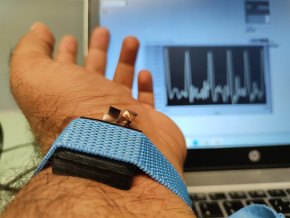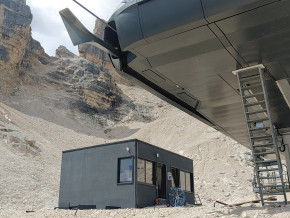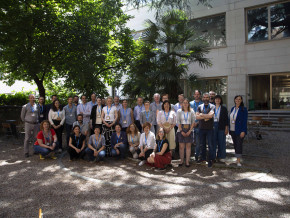Unique collaboration between Eurac Research and Bolivian Government
Groundbreaking study of Bolivia’s rich bioarcheological record now underway.
An inter-institutional cooperation agreement between the Eurac Research Institute for Mummy Studies in Bolzano, Italy and the Plurinational State of Bolivia’s Ministry of Cultures, Decolonization and Despatriarchalization has just been signed to establish reciprocal technical assistance for the research and conservation of the Bolivian cultural heritage. In addition, the Institute of Mummies developed, constructed, and donated 10 long-term conservation chambers to safeguard the mummified remains of pre-Columbian individuals housed at MUNARQ - the National Museum of Archaeology in La Paz.
Bolivia’s museums house a wealth of pottery, lithics and metalwork, yet bioarcheological research in Bolivia is currently not as well-developed as its classical archaeological counterpart where until now, predominant focus has been on traditional artifacts. In La Paz’s National Museum of Archaeology, a substantial piece of Bolivia’s bioarcheological record has for the past 50 years, been awaiting investigation: almost 50 complete mummified bodies and more than 500 human skulls. The partnership between the museum in La Paz and the Eurac Research Institute for Mummy Studies was proposed by Seal of Excellence researcher Guido Valverde, himself from Bolivia. The ongoing project will review this valuable bioarcheological information through Computer Tomography analysis to gain insights into the lifestyles and pathologies that affected these individuals. A particular focus will be given to analyzing the presence of atherosclerosis - until now thought of as a modern disease but for which there is evidence that the pathology is in fact an inherent component of human aging. Paleogenetic DNA analysis will also reveal the genetic diversity of these ancient South American human populations and provide valuable insights into the interactions between genetics, environment, lifestyle, and their impact the health of these individuals for the first time.

At the press conference which took place in La Paz, which brought together Institute Head Albert Zink and The Plurinational State of Bolivia’s Minister of Cultures, Sabina Orellana, Zink highlighted “It is a unique occasion and highly important to have the collaboration with someone who comes from Bolivia and be able to work on directly on these individuals here in La Paz.” The signing of the agreement has cemented the alliance between the Italian and Bolivian Institutes and the multidisciplinary team of biologists, cardiologists, conservationists, anthropologists, and archaeologists. He went on to add “The opportunities presented here will enable the development of conservation strategies to preserve such cultural heritage for future generations.”
The Minister of Cultures, Sabina Orellana, emphasized that, in compliance with the State task of guaranteeing the conservation and preservation of the Bolivian cultural heritage, the agreement has been promoted with the objective of achieving an integral, effective and efficient inter-institutional cooperation framework for joint and coordinated work.
The project is funded by the Autonomous Province of Bolzano’s Seal of Excellence Grant “MUMBO”.
Video: https://www.youtube.com/watch?v=PFVooZFo7HI
Related Articles

Tecno-prodotti. Creati nuovi sensori triboelettrici nel laboratorio di sensoristica al NOI Techpark
I wearable sono dispositivi ormai imprescindibili nel settore sanitario e sportivo: un mercato in crescita a livello globale che ha bisogno di fonti di energia alternative e sensori affidabili, economici e sostenibili. Il laboratorio Sensing Technologies Lab della Libera Università di Bolzano (unibz) al Parco Tecnologico NOI Techpark ha realizzato un prototipo di dispositivo indossabile autoalimentato che soddisfa tutti questi requisiti. Un progetto nato grazie alla collaborazione con il Center for Sensing Solutions di Eurac Research e l’Advanced Technology Institute dell’Università del Surrey.

unibz forscht an technologischen Lösungen zur Erhaltung des Permafrostes in den Dolomiten
Wie kann brüchig gewordener Boden in den Dolomiten gekühlt und damit gesichert werden? Am Samstag, den 9. September fand in Cortina d'Ampezzo an der Bergstation der Sesselbahn Pian Ra Valles Bus Tofana die Präsentation des Projekts „Rescue Permafrost " statt. Ein Projekt, das in Zusammenarbeit mit Fachleuten für nachhaltiges Design, darunter einem Forschungsteam für Umweltphysik der unibz, entwickelt wurde. Das gemeinsame Ziel: das gefährliche Auftauen des Permafrosts zu verhindern, ein Phänomen, das aufgrund des globalen Klimawandels immer öfter auftritt. Die Freie Universität Bozen hat nun im Rahmen des Forschungsprojekts eine erste dynamische Analyse der Auswirkungen einer technologischen Lösung zur Kühlung der Bodentemperatur durchgeführt.

Gesunde Böden dank Partizipation der Bevölkerung: unibz koordiniert Citizen-Science-Projekt ECHO
Die Citizen-Science-Initiative „ECHO - Engaging Citizens in soil science: the road to Healthier Soils" zielt darauf ab, das Wissen und das Bewusstsein der EU-Bürger:innen für die Bodengesundheit über deren aktive Einbeziehung in das Projekt zu verbessern. Mit 16 Teilnehmern aus ganz Europa - 10 führenden Universitäten und Forschungszentren, 4 KMU und 2 Stiftungen - wird ECHO 16.500 Standorte in verschiedenen klimatischen und biogeografischen Regionen bewerten, um seine ehrgeizigen Ziele zu erreichen.

Erstversorgung: Drohnen machen den Unterschied
Die Ergebnisse einer Studie von Eurac Research und der Bergrettung Südtirol liegen vor.
